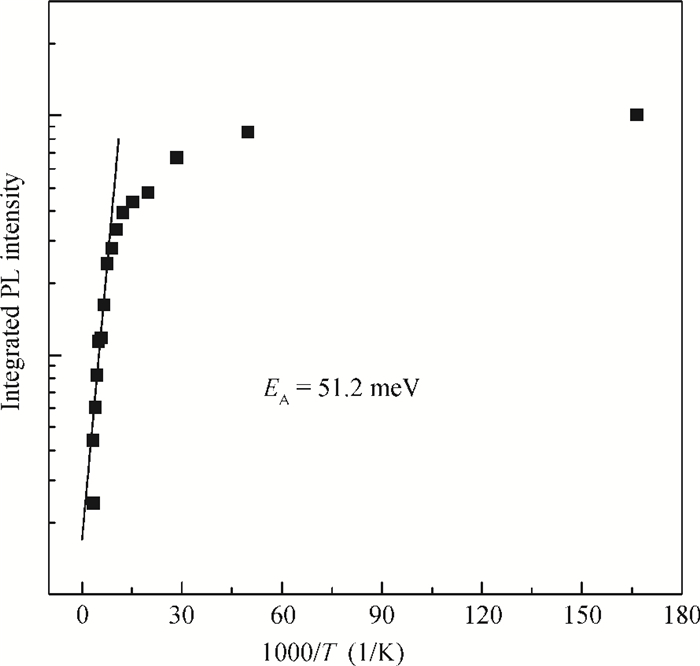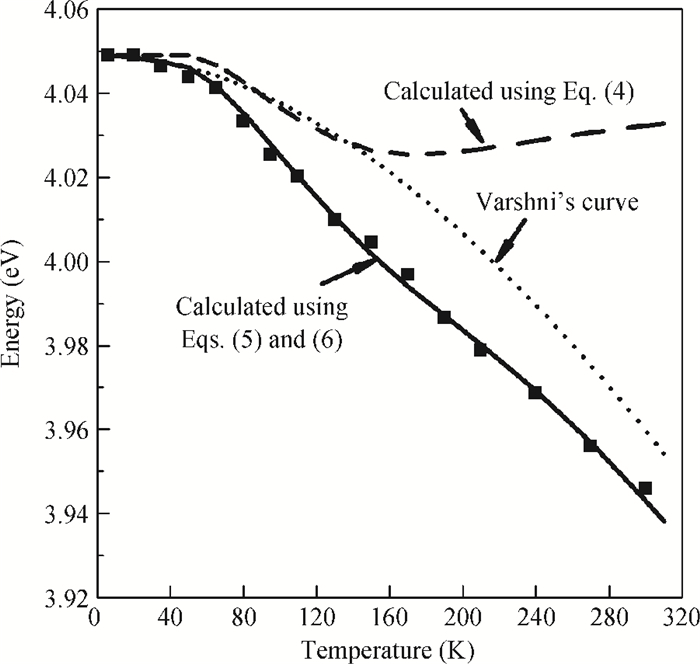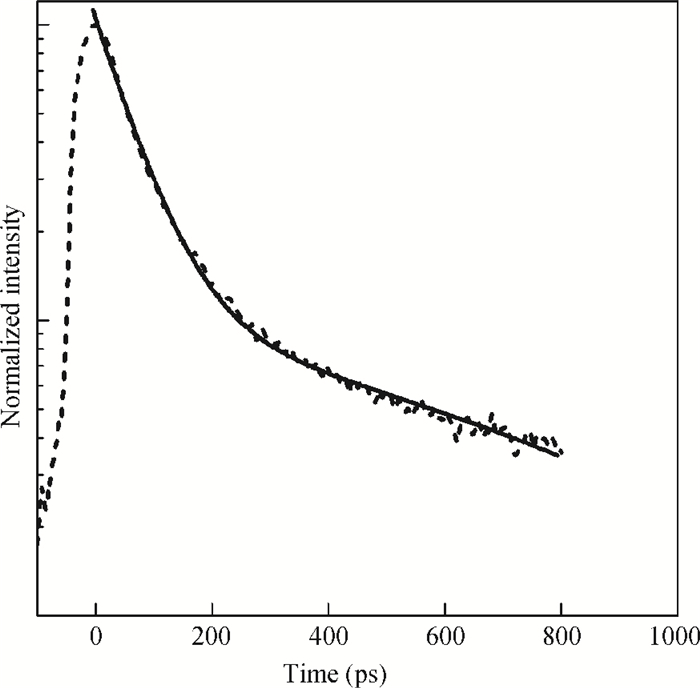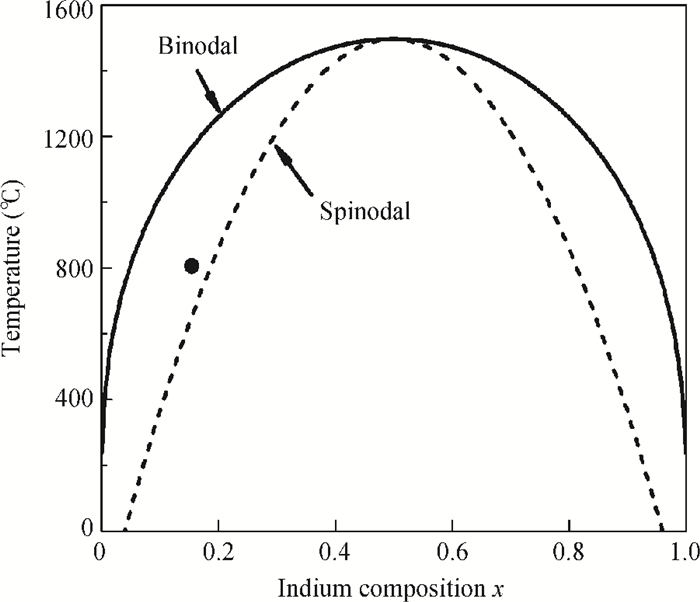| Citation: |
Wei Li, Peng Jin, Weiying Wang, Defeng Mao, Guipeng Liu, Zhanguo Wang, Jiaming Wang, Fujun Xu, Bo Shen. Anomalous temperature-dependent photoluminescence peak energy in InAlN alloys[J]. Journal of Semiconductors, 2014, 35(9): 093001. doi: 10.1088/1674-4926/35/9/093001
****
W Li, P Jin, W Y Wang, D F Mao, G P Liu, Z G Wang, J M Wang, F J Xu, B Shen. Anomalous temperature-dependent photoluminescence peak energy in InAlN alloys[J]. J. Semicond., 2014, 35(9): 093001. doi: 10.1088/1674-4926/35/9/093001.
|
Anomalous temperature-dependent photoluminescence peak energy in InAlN alloys
DOI: 10.1088/1674-4926/35/9/093001
More Information
-
Abstract
InAlN has been studied by means of temperature-dependent time-integrated photoluminescence and time-resolved photoluminescence. The variation of PL peak energy did not follow the behavior predicted by Varshni formula, and a faster redshift with increasing temperature was observed. We used a model that took account of the thermal activation and thermal transfer of localized excitons to describe and explain the observed behavior. A good fitting to the experiment result is obtained. We believe the anomalous temperature dependence of PL peak energy shift can be attributed to the temperature-dependent redistribution of localized excitons induced by thermal activation and thermal transfer in the strongly localized states. V-shaped defects are thought to be a major factor causing the strong localized states in our In0.153Al0.847N sample.-
Keywords:
- InAlN,
- photoluminescence,
- thermal activation,
- V-defects
-
References
[1] Choi S, Kim H J, Kim S S, et al. Improvement of peak quantum efficiency and efficiency droop in Ⅲ-nitride visible light-emitting diodes with an InAlN electron-blocking layer. Appl Phys Lett, 2010, 96:221105 doi: 10.1063/1.3441373[2] Chen Z T, Sakai Y, Zhang J C, et al. Effect of strain on quantum efficiency of InAlN-based solar-blind photodiodes. Appl Phys Lett, 2009, 95:083504 doi: 10.1063/1.3213562[3] Ganguly S, Konar A, Hu Z Y, et al. Polarization effects on gate leakage in InAlN/AlN/GaN high-electron-mobility transistors. Appl Phys Lett, 2012, 101:253519 doi: 10.1063/1.4773244[4] Berger C, Dadgar A, Bläsing J, et al. Growth of AlInN/AlGaN distributed Bragg reflectors for high quality microcavities. Phys Status Solidi C, 2012, 9:1253 doi: 10.1002/pssc.v9.5[5] Deĭbuk V G, Voznyĭ A V. Thermodynamic stability and redistribution of charges in ternary AlGaN, InGaN, and InAlN Alloys. Semiconductors, 2005, 39:623 doi: 10.1134/1.1944849[6] Ferhat M, Bechstedt F. First-principles calculations of gap bowing in InxGa1-xN and InxAl1-xN alloys:relation to structural and thermodynamic properties. Phys Rev B, 2002, 65:075213 doi: 10.1103/PhysRevB.65.075213[7] Jones R E, Broesler R, Yu K M, et al. Band gap bowing parameter of In1-xAlxN. J Appl Phys, 2008, 104:123501 doi: 10.1063/1.3039509[8] Wang K, Martin R W, Amabile D, et al. Optical energies of AlInN epilayers. J Appl Phys, 2008, 103:073510 doi: 10.1063/1.2898533[9] Iliopoulos E, Adikimenakis A, Giesen C, et al. Energy bandgap bowing of InAlN alloys studied by spectroscopic ellipsometry. Appl Phys Lett, 2008, 92:191907 doi: 10.1063/1.2921783[10] Eliseev P G, Perlin P, Lee J, et al. "Blue" temperature-induced shift and band-tail emission in InGaN-based light sources. Appl Phys Lett, 1997, 71:569 doi: 10.1063/1.119797[11] Cho Y H, Gainer G H, Lam J B, et al. Dynamics of anomalous optical transitions in AlxGa1-xN alloys. Phys Rev B, 2000, 61:7203 doi: 10.1103/PhysRevB.61.7203[12] Li Q, Xu S J, Cheng W C, et al. Thermal redistribution of localized excitons and its effect on the luminescence band in InGaN ternary alloys. Appl Phys Lett, 2001, 79:1810 doi: 10.1063/1.1403655[13] Kamimura J, Kishino K, Kikuchi A. Low-temperature photoluminescence studies of In-rich InAlN nanocolumns. Phys Status Solidi RRL, 2012, 6(3):123 doi: 10.1002/pssr.v6.3[14] Miao Z L, Yu T J, Xu F J, et al. Strain effects on InxAl1-xN crystalline quality grown on GaN templates by metalorganic chemical vapor deposition. J Appl Phys, 2010, 107:043515 doi: 10.1063/1.3305397[15] Bacher G, Hartmann C, Schweizer H, et al. Exciton dynamics in InxGa1-xAs/GaAs quantum-well heterostructures:competition between capture and thermal emission. Phys Rev B, 1993, 47:9545 doi: 10.1103/PhysRevB.47.9545[16] Varshni Y P. Temperature dependence of the energy gap in semiconductors. Physica, 1967, 34:149 doi: 10.1016/0031-8914(67)90062-6[17] Jiang L F, Shen W Z, Guo Q X. Temperature dependence of the optical properties of AlInN. J Appl Phys, 2009, 106:013515 doi: 10.1063/1.3160299[18] Xu Z Y, Lu Z D, Yuan Z L, et al. Thermal activation and thermal transfer of localized excitons in InAs self-organized quantum dots. Superlattices Microstruct, 1998, 23:381 http://www.sciencedirect.com/science/article/pii/S0749603696901962#![19] Onuma T, Chichibu S F, Uchinuma Y, et al. Recombination dynamics of localized excitons in Al1-xInxN epitaxial films on GaN templates grown by metalorganic vapor phase epitaxy. J Appl Phys, 2003, 94:2449 doi: 10.1063/1.1592868[20] Onuma T, Chichibu S F, Uedono A, et al. Radiative and nonradiative processes in strain-free AlxGa1-xN films studied by time-resolved photoluminescence and positron annihilation techniques. J Appl Phys, 2004, 95:2495 doi: 10.1063/1.1644041[21] Gotoh H, Ando H, Takagahara T, et al. Effects of dimensionality on radiative recombination lifetime of excitons in thin quantum boxes of intermediate regime between zero and two dimensions. Jpn J Appl Phys, 1997, 36:4204 doi: 10.1143/JJAP.36.4204[22] Wei Q Y, Li T, Huang Y, et al. Compositional instability in InAlN/GaN lattice-matched epitaxy. Appl Phys Lett, 2012, 100:092101 doi: 10.1063/1.3690890[23] Kehagias Th, Dimitrakopulos G P, Kioseoglou J, et al. Indium migration paths in V-defects of InAlN grown by metal-organic vapor phase epitaxy. Appl Phys Lett, 2009, 95:071905 doi: 10.1063/1.3204454[24] Minj A, Cavalcoli D, Cavallini A. Indium segregation in AlInN/AlN/GaN heterostructures. Appl Phys Lett, 2010, 97:132114 doi: 10.1063/1.3489433[25] Miao Z L, Yu T J, Xu F J, et al. The origin and evolution of V-defects in InxAl1-xN epilayers grown by metalorganic chemical vapor deposition. Appl Phys Lett, 2009, 95:231909 doi: 10.1063/1.3272017[26] Song J, Xu F J, Yan X D, et al. High conductive gate leakage current channels induced by In segregation around screw-and mixed-type threading dislocations in lattice-matched InxAl1-xN/GaN heterostructures. Appl Phys Lett, 2010, 97:232106 doi: 10.1063/1.3525713[27] Wu X H, Elsass C R, Abare A, et al. Structural origin of V-defects and correlation with localized excitonic centers in InGaN/GaN multiple quantum wells. Appl Phys Lett, 1998, 72:692 doi: 10.1063/1.120844 -
Proportional views





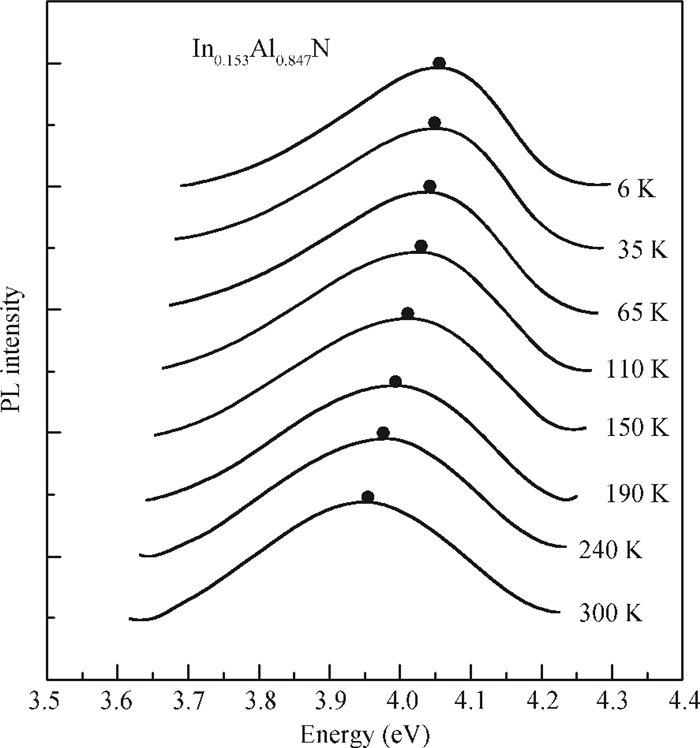
 DownLoad:
DownLoad:
